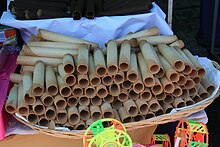Barquillo is a crispy rolled wafer pastry originating in Spain. It is made from the basic cookie ingredients of flour, sugar, egg whites and butter rolled out thinly and then shaped into a hollow cylinder or a cone. It was traditionally sold by roadside vendors known as barquilleros who carried a characteristic red roulette tin (the ruleta de barquillero). It was introduced to Latin America and the Philippines during colonial times. In Spain and former Spanish colonies, barquillos are commonly regarded as a type of Christmas cookie. It is also popular during various fiestas. It spread to neighboring countries and today is extremely popular in East and Southeast Asian countries.[1][2][3]
 | |
| Alternative names | Biscuit roll, crispy biscuit roll, crisp biscuit roll, cookie roll, love letter |
|---|---|
| Type | Biscuit |
| Place of origin | |
| Variations | Barquiron, Cuchuflí |
Names
editThe Spanish name barquillo means "little boat". It is derived from the ancient tradition of heating the biscuits in convex or boat-shaped molds. Barquillos are also known by a variety of names. In English it is also known as biscuit roll, cookie roll, crispy biscuit roll, egg roll, crisp biscuit roll, or love letter. The Chinese name for this snack, "蛋卷", can be directly translated into English as "egg roll". However, the food item known in the West as egg roll is very different.
Description
editBarquillos are thin wafers made from flour, sugar, egg whites and butter that is rolled into the shape of a long hollow tube or a cone. They can also be sold simply folded over twice in a fan shape. In Spain, it was traditionally sold by roaming roadside vendors known as "barquilleros" (or "barquilleras") during festive events. In Madrid, barquilleros are particularly associated with the fiesta of San Isidro Labrador, where the vendors typically dress in castizo (chulapo) attire.[4]
Barquilleros carry a characteristic red tin known as the ruleta de barquillero which has a roulette spinner at the top. Buying barquillos typically involve a small game, where the buyer pays to spin the roulette. Depending on where the ticker lands, the buyer can either have one or two barquillos for the same price. The buyer can also pay a slightly larger amount to continue spinning the roulette and getting barquillos until it lands on one of the four golden markers.[3]
The tradition of barquilleros almost became extinct during the dictatorship of Francisco Franco.[3] Today, barquillos are most popular in Asia which has a larger population than Spain.[1]
Barquillos are traditionally eaten plain. Modern versions, however, can flavor it with ingredients including vanilla, cinnamon, grated coconut, and lemon juice. Barquillos are also commonly dipped or coated in milk chocolate or have a chocolate center.[4] Due to their similarity to ice cream cones, they are also commonly sold as containers for frozen treats.[3]
Similar recipes to barquillos also exist in other countries in Europe, like the parizske pecivo of Czechoslovakia, the pirouettes of France, and krumkake of Norway. Flat versions are known as wafle in Poland, goro in Norway, and pizzelle in Italy, among others.[5]
By region
editLatin America
editIn Argentina and Chile, cylindrical barquillos filled with dulce de leche, chocolate, or other sweet fillings are known as cuchuflís (Chile) or cubanitos (Argentina).[6]
Asia
editBarquillos in the Philippines lack the grid-pattern of traditional Spanish barquillos. They are thinner and are usually rolled into elongated cylindrical shapes.[7] Philippine barquillos are most strongly associated with the city of Iloilo, particularly to the Deocampo bakery in the district of Jaro, which has been commercially mass-producing barquillos since 1896.[8] Prior to mid 1960s, It used to be known only to the wealthy as they were sold in cans at expensive prices. Mrs. Alejandra Cordova produced and packed the barquillos in 4s and 8s, making them affordable to the masses. She was also one of the first to introduce barquiron (and coined the term, from barquillos and polvoron, with and without ground roasted peanuts). Most notable was the Cordova's Special Barquillos' use of fresh butter, egg yolks, and vanilla, aside from the traditional flour, milk and sugar.
A notable variant of barquillo is the Filipino barquiron (also spelled barqueron), which are barquillos filled with polvorón and crushed peanuts, cashew nuts, or pili nuts. It originates from the city of Iloilo.[9] Other variants of Philippine barquillos include those flavored with ube, pandan leaves, and carrots, which are bright purple, green, and orange in color, respectively.[10]
In Hong Kong, biscuit rolls are made of wheat flour, butter, egg, sugar, and vanilla flavour.[11]
Gallery
editSee also
editReferences
edit- ^ a b "Cookie Roll". biscuit people. Retrieved 31 January 2019.
- ^ Coxall, Malcolm (2013). Traditional Christmas Recipes of Spain. Cornelio Books. ISBN 9788494178306.
- ^ a b c d "Barquilleros of Madrid". Gastro Obscura. Atlas Obscura. Retrieved 31 January 2019.
- ^ a b "Los últimos del barquillo". Guía Repsol. Retrieved 31 January 2019.
- ^ "Czech Pirouette Cookies (Parizske Pecivo)". The Spruce Eats. Retrieved 31 January 2019.
- ^ "Cuchufli cookie from Chile". Cookie Companion. 28 August 2016. Retrieved 31 January 2019.
- ^ Piccio, Belle. "Barquillos And Barquiron: Spanish-Inspired Ilonggo Snacks That Filipinos Love". ChoosePhilippines. Archived from the original on April 4, 2018. Retrieved 31 January 2019.
- ^ Piccio, Belle. "Why Barquillos is the Most Delicious in the City of Love". ChoosePhilippines. Archived from the original on December 1, 2016. Retrieved 31 January 2019.
- ^ Biol, Kate (12 October 2017). "A Foodie's Checklist for Iloilo". TripZilla.ph. Retrieved 31 January 2019.
- ^ "Barquillos: Choose your flavour and color". Flavours of Iloilo. Retrieved 31 January 2019.
- ^ Mijune (30 May 2010). "Best Egg Rolls". Follow Me Foodie. Archived from the original on 15 August 2012. Retrieved 11 August 2012.
External links
edit- Media related to Barquillos at Wikimedia Commons